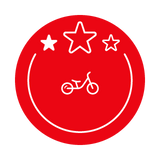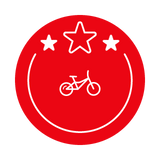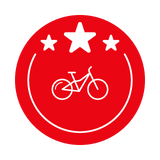From the first balancing act to the riding pro
Step by Step, our bikes grow with the skills of children. We are there for an excellent ride from the start, all the way to mastering pedaling and gears. woom accompanies the children with super-slim, thought-out bikes for ages one and a half to fourteen years. No training wheels, no problem.
Ride advice starts here
Click here for our tips
Tips for pros here

The First Step in Cycling: Finding Balance
Curiosity begins right when a child can walk. With a deep saddle and cleverly-placed high handlebar, the balance bike is comparable to your child's next steps after walking. Gradually, the steps to push the wheel forward gain in length, then they will begin to roll.
A helpful way to start your child's balance bike adventure is in a gently sloping area that ever-so-slowly has segments that slope down. Soft trails may be ideal. We always strongly encourage helmet and glove use. Let your child take control and start using their feet and mind for balance!
"The ideal time to get on a Balance Bike is between 1.5 and 2.5 years. The most important thing is that children want to get on the bike themselves - nothing can be forced under pressure!"

Pedal bikes made easy:
Kids using pedals in no time
No training wheels, no problem. In an important moment, your child will take on a real pedal bike. If they have already learned on a balance bike, they have a head start; if not, we have them covered. All of our bikes can be used as a 'balance bike' with the pedals left off (which is how the bike arrives), allowing children of all ages and all skill backgrounds to become powerful, advanced riders using our pedal bikes when the child is ready for you to attach the pedals. No training wheels—no problem.
Ready to ride (and brake). With your help, your child's drive to pedal will be a piece of cake. With your guiding voice, their eyes set straight ahead as they take off, and a lightweight woom bike, they will be all set to master their riding skills. As they quickly grasp the pedals, the young rider will appreciate the color-coded green right hand brake that corresponds to the green back wheel brake. Riding has never been this much fun!
"Children usually learn pedal bikes between 3-5 years. The best way to help them master the learning process is to make them feel comfortable on a bike."

Refine, improve, learn ...
Skill Training
The Riding Horizon is Expanding. The riding horizon is expanding. Kids start riding on roads and off-road and also work on cornering. Riding uphill and downhill is part of their exploration. A single speed is no longer enough and kids now need gears to shift. woom bikes offer an easy to use and quiet gear shifter. This will help them learn shifting quickly and use it when exploring more challenging terrain. Some use their bike just for fun or ride with friends or use it for competition or all of the above. It's important to introduce new concepts or new terrain to continuously challenge our kids. Coaching and teaching kids on bikes will immediately pay off.
Little Rider. Whether it's for riding around the neighborhood, a commuting bike for school or just to ride around with friends, the woom bike is a powerful transportation device. By making going out on a bike such a pleasant experience, your little rider will become confident and happy—even if they learned how to ride already, they will be pleased with the woom bike's infrastructure and will take their riding to new levels.
"With a nice, long day of practice at the local park, a kid can learn to ride a bike with ease."